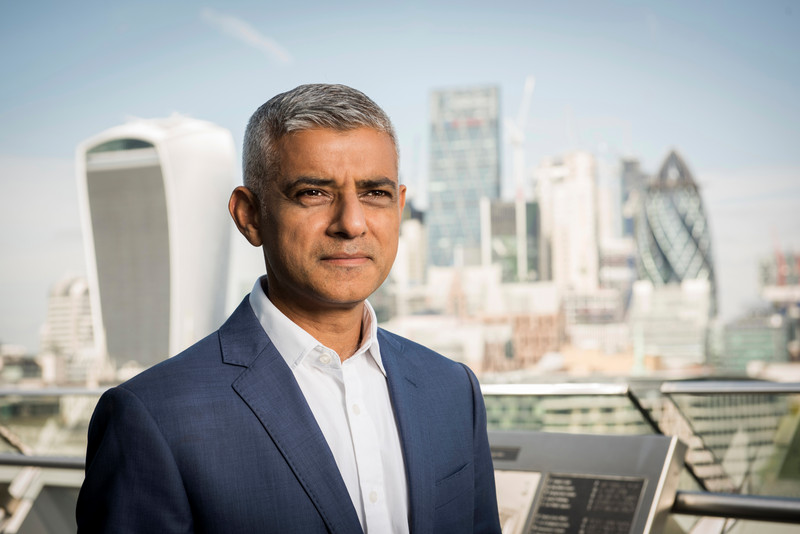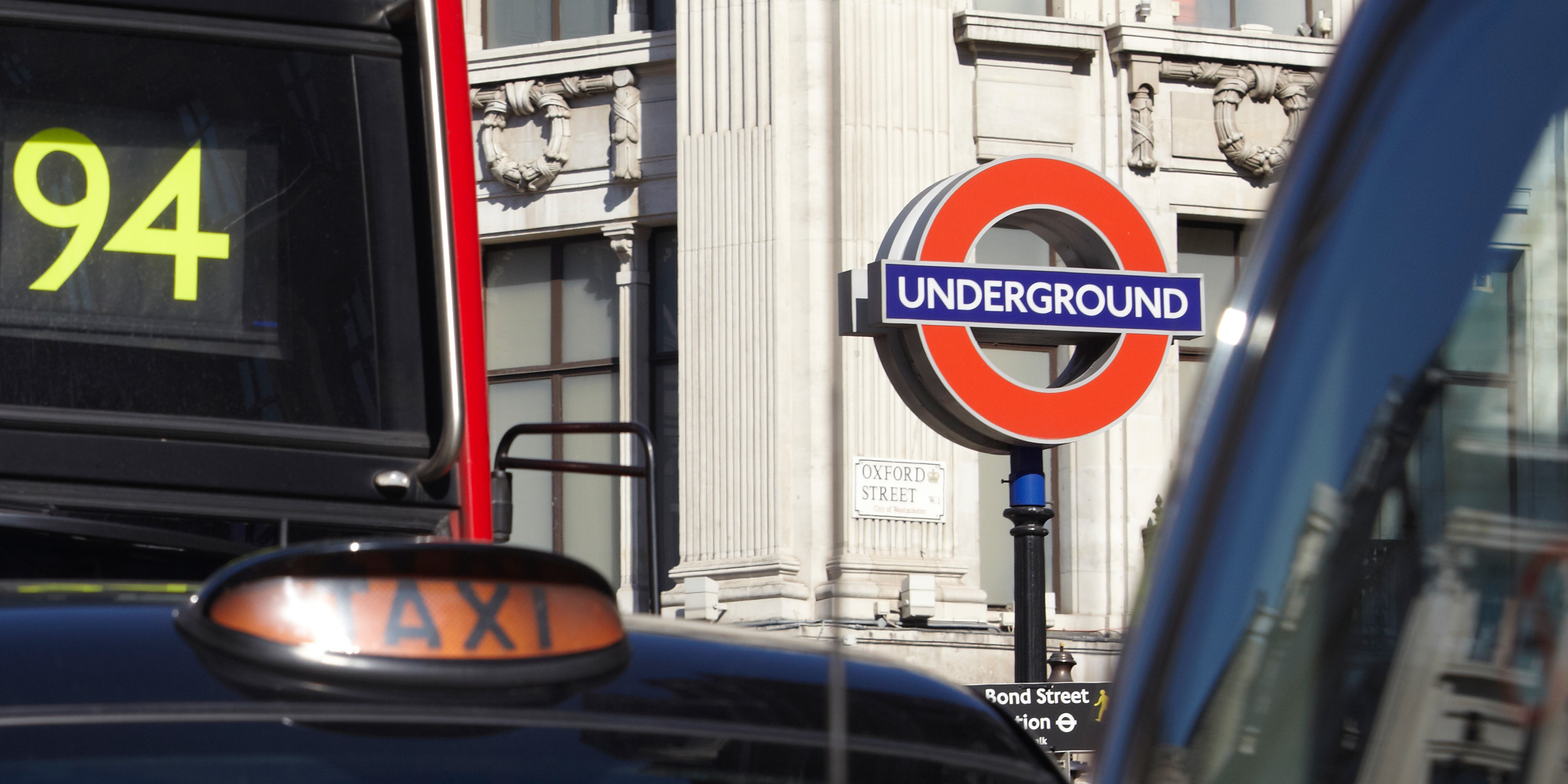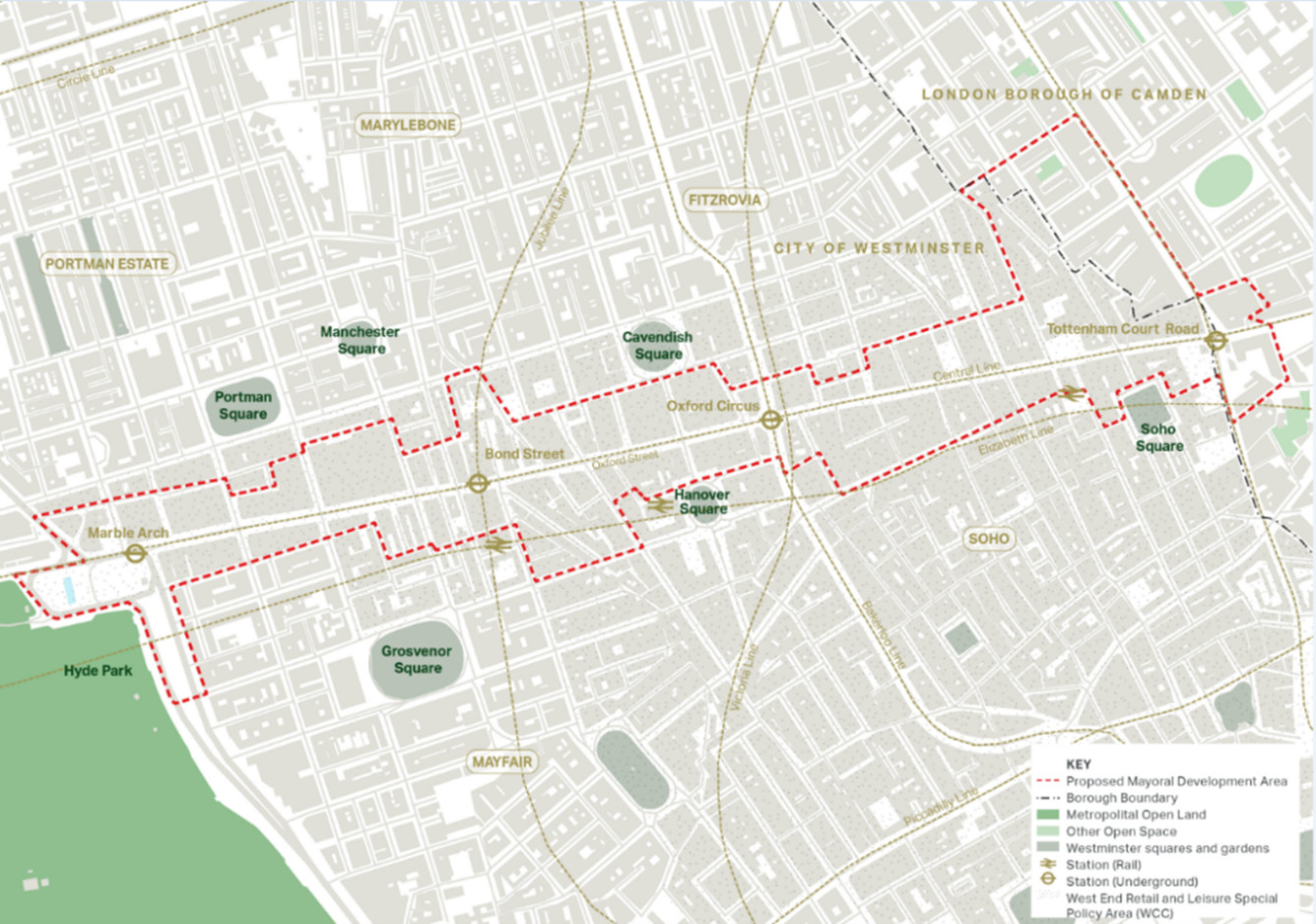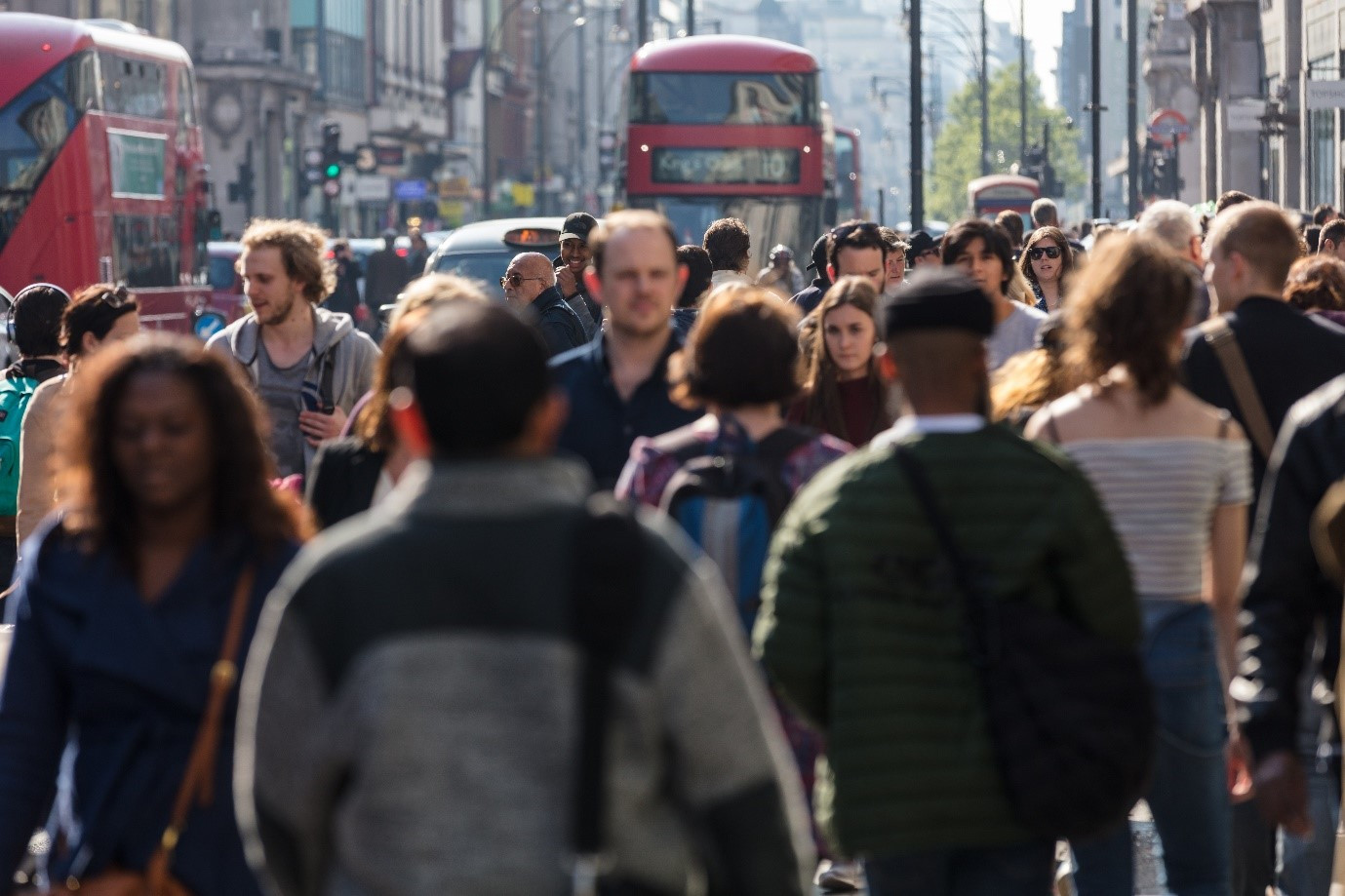Oxford Street in London stands as the UK’s quintessential high street, a renowned destination celebrated for its mix of British heritage brands and international retailers. Historically, it has been a cornerstone of London’s retail scene, drawing visitors from across the globe. However, recent shifts in consumer behavior, accelerated by the pandemic and the surge in online shopping, have presented significant challenges, leading to a noticeable decline in its vibrancy. While local initiatives have begun to address these issues, a more comprehensive and accelerated approach is needed to restore Oxford Street to its former glory and ensure its continued success.
 Mayor of London, Sadiq Khan, advocating for the revitalization of Oxford Street, with the London skyline in the background
Mayor of London, Sadiq Khan, advocating for the revitalization of Oxford Street, with the London skyline in the background
Recognizing the urgency and scale of the task, the Mayor of London is championing ambitious proposals to pedestrianize Oxford Street. This initiative aims to fundamentally transform the area into a dynamic, green, and thriving destination that appeals to both Londoners and international tourists. The vision is to elevate Oxford Street to compete with world-leading shopping and leisure destinations such as Fifth Avenue in New York and the Champs-Élysées in Paris, ensuring its status as a global icon.
This rejuvenation project is envisioned to be a catalyst for attracting increased international tourism, showcasing the best of London to a global audience and inviting the world to experience the unique charm of Oxford Street. Furthermore, the transformation is expected to act as a powerful magnet for new investments and job creation, driving substantial economic growth and prosperity for London and the UK for decades to come.
 Diverse modes of transport in London, showcasing the accessibility of Oxford Street with an underground sign, a number 94 bus, and a taxi cab
Diverse modes of transport in London, showcasing the accessibility of Oxford Street with an underground sign, a number 94 bus, and a taxi cab
The proposals are carefully designed to unlock the full potential of Oxford Street, focusing on creating a world-class environment that is safe, accessible, and clean for everyone. The goal extends beyond mere aesthetic improvements; it is about transforming Oxford Street into a vibrant public space where people can shop, dine, socialize, and, most importantly, feel a sense of pride in a renewed London landmark. To spearhead this ambitious project, the Mayor proposes establishing a new Mayoral Development Corporation (MDC) specifically for Oxford Street. This body would be equipped with the necessary authority and resources to oversee and expedite the area’s transformation. Public engagement is considered crucial to the success of this vision, and all Londoners are encouraged to participate and contribute to shaping the future of Oxford Street.
Delivering Transformative Change to Oxford Street
To effectively realize the ambitious vision for Oxford Street, the establishment of a Mayoral Development Corporation (MDC) is proposed. This strategic body would provide the focused leadership and coordinated effort necessary to cultivate an appealing environment for visitors, residents, and businesses, thereby stimulating significant economic growth in the area.
While local authorities, namely Westminster City Council and the London Borough of Camden, have already made strides in improving Oxford Street – such as reducing the prevalence of souvenir and candy shops and diversifying the retail offerings – the pace of change needs to accelerate. Collaborative efforts involving business stakeholders, landowners, and local councils, including the New West End Company (NWEC), Oxford Street’s Business Improvement District, have yielded positive outcomes.
However, in comparison to neighboring areas like Regent Street and Bond Street, which are experiencing a more rapid recovery, Oxford Street’s progress is lagging. This disparity underscores the need for a fresh, more impactful strategy to drive substantial transformation.
The creation of a dedicated authority, the MDC, focused exclusively on Oxford Street and its immediate vicinity, is seen as a pivotal step. This entity would concentrate solely on establishing Oxford Street as a premier global destination for shopping, leisure, and outdoor events. Given Oxford Street’s strategic importance to London and the UK as a whole, the Mayor’s direct involvement is essential to ensure that it achieves its full potential.
The primary role of the MDC would be to spearhead and coordinate initiatives aimed at enhancing the environment, diversifying retail and leisure options, and activating newly created public spaces resulting from pedestrianization. It would ensure a cohesive and transformative design for the area, promoting Oxford Street as a globally recognized retail and leisure destination.
The MDC’s structure would be carefully designed to ensure it focuses precisely on the area essential for realizing the Mayor’s vision for Oxford Street. It would be granted only the necessary powers to achieve this objective, aligning its operations with existing frameworks wherever feasible.
The Mayor’s proposal includes:
- Designating a new Mayoral Development Area (MDA) encompassing Oxford Street and its immediate surroundings to the required extent. The proposed boundary is detailed in the map provided. Upon formal MDA designation, the Secretary of State can initiate the parliamentary procedures necessary to establish the MDC.
- Empowering the MDC with responsibilities for planning and determining planning applications. This would enable the development and implementation of a unified vision for Oxford Street, reflecting its local, London-wide, and national significance.
 Map outlining the proposed Mayoral Development Area for Oxford Street
Map outlining the proposed Mayoral Development Area for Oxford Street
Creating an Enhanced Environment Through Pedestrianization
The aspiration for Oxford Street to reach its zenith is significantly challenged by persistently crowded sidewalks and heavy traffic. These conditions negatively impact the visitor experience and hinder the street’s potential.
To address these issues and support the comprehensive regeneration of the area, the Mayor advocates for the phased pedestrianization of Oxford Street. This strategic move aims to create a more appealing local environment and substantially improve the quality and usability of public spaces. The initial phase would focus on the section between Oxford Circus and Orchard Street. This is part of a broader initiative to develop a world-class public realm, which includes enhancements to areas of Oxford Street that may require a longer timeframe for full pedestrianization, such as the eastern section of the street beyond Oxford Circus.
 Oxford Street scene depicting pedestrians and buses, highlighting the current mixed-use environment
Oxford Street scene depicting pedestrians and buses, highlighting the current mixed-use environment
Pedestrianization would entail removing most vehicular traffic from Oxford Street, leading to improvements in air quality and a reduction in road hazards. This transformation would unlock new possibilities for utilizing the street space, including hosting a variety of events and activities. These activations would attract new visitors and enhance Oxford Street’s reputation as a premier destination, creating a more inclusive and welcoming environment for residents and visitors alike.
Economically, pedestrianization is projected to stimulate growth and generate substantial benefits. Experiences from pedestrianization projects in other cities, both in the UK and internationally, indicate a trend of increased foot traffic and consumer spending. These improvements typically correlate with enhanced economic activity and increased store revenues. For instance, research on pedestrianized zones in Spanish cities revealed that “stores in pedestrian environments tend to achieve higher sales volumes compared to stores on conventional streets.” GLA Economics (2024) estimates suggest that a pedestrianized Oxford Street could generate nearly £82 million more in annual sales and support an additional 781 jobs compared to a non-pedestrianized scenario.
The concept of pedestrianizing Oxford Street was initially proposed by the Mayor in his 2016 manifesto, with detailed plans undergoing public consultation in 2017. However, these plans were put on hold when Westminster City Council withdrew its support. Since then, the rationale for pedestrianization has become even stronger, particularly with the 2022 opening of the Elizabeth line, which includes step-free access stations at Bond Street and Tottenham Court Road. This enhanced accessibility provides a renewed opportunity to revisit and refine the 2017 proposals.
Why Pedestrianize Oxford Street? The Benefits Explained
Oxford Street’s enduring appeal as the UK’s high street stems from its rich blend of retail, leisure, and cultural offerings, combined with unparalleled transport connectivity. It is served by five underground lines (Central, Victoria, Jubilee, Northern, and Bakerloo), numerous bus routes, and now the Elizabeth Line, with key stations at Bond Street and Tottenham Court Road.
Oxford Street is a significant economic engine, contributing substantially to both London and the national economy. Annually, it welcomes approximately 120 million visitors, with 85% arriving via public transport. In 2022, its economic contribution to London was estimated at £25 billion, representing nearly 5% of London’s total Gross Value Added (GVA) and 1% of the UK’s total economic output.
However, Oxford Street has faced considerable challenges in recent years, primarily due to the impacts of the pandemic and the growing dominance of online retail. These factors have collectively dampened its economic performance and visitor appeal.
The recovery of Oxford Street from the pandemic has been notably slower than comparable areas like Bond Street and Regent Street, as well as the broader West End and Central Activity Zone (CAZ). This slower recovery suggests that current visitor, investor, and business expectations regarding the quality of the environment, amenities, and retail and leisure offerings are not being adequately met. Several key metrics highlight this trend:
- Footfall: Data from November 2024 indicates that pedestrian traffic on Oxford Street is only at 57% of 2006 levels, significantly lower than Bond Street (98%) and Regent Street (83%).
- Consumer Spending: Spending recovery on Oxford Street lags the West End average by 9% on weekdays, with the weekend gap widening to 16%. Furthermore, inflation-adjusted spending between 9 pm and 6 am on Oxford Street has declined by 29% between 2022 and 2024, showing a decrease in evening spending across all days of the week.
- Rental Values: Research from the New West End Company (NWEC) indicates that prime rents on Oxford Street are down 36% compared to pre-pandemic peaks. This decline is more pronounced than in Bond Street (-10%) and Regent Street (-24%).
This decline negatively affects both international and domestic perceptions of London and the UK. Urgent and decisive action is essential to reverse this trend and revitalize Oxford Street, injecting new life into the nation’s high street.
The Mayor’s proposals aim to collaborate with local leaders, businesses, and the government to regenerate Oxford Street. The vision is to transform it into a vibrant, green, and attractive destination for both London residents and tourists. Pedestrianization and the enhancement of public spaces are central to this strategy. The ongoing consultation process is focused on refining and implementing these proposals.
The overarching goal is to re-establish Oxford Street as a global leader in shopping, leisure, and outdoor events, rivaling iconic destinations like Fifth Avenue in New York, the Champs-Élysées in Paris, and the Ginza district in Tokyo. This revitalization is expected to attract more international visitors, showcase London’s best aspects to the world, and serve as a catalyst for new investment and job creation, fostering long-term economic prosperity.
The Mayor’s plans are designed to fully realize Oxford Street’s potential, creating a beautiful, safe, and inclusive environment where people can shop, dine, and connect. Ultimately, the aim is to make Oxford Street a source of pride for Londoners and the entire country.
How Pedestrianization Will Be Implemented
The following outlines the potential benefits of pedestrianizing Oxford Street and the necessary adjustments to achieve these advantages. Detailed plans for pedestrianization are still under development and will be subject to further consultation. The aim is to ensure that post-pedestrianization, Oxford Street remains highly accessible to all.
Bus Route Adaptations
Pedestrianizing Oxford Street will necessitate rerouting some or all existing bus services that currently operate along the street.
Due to broader network modifications, the number of buses on Oxford Street has already decreased significantly, from over 130 per hour in 2016 to 35 per hour currently in each direction. Currently, eight daytime and nine nighttime bus routes serve Oxford Street.
Given the substantial demand for bus travel to and through the Oxford Street area, any pedestrianization plan must carefully consider the relocation of bus stops and stands to maintain convenient public transport access.
The Elizabeth line stations at Bond Street and Tottenham Court Road offer new step-free travel options to and from Oxford Street, enhancing overall accessibility and partially mitigating changes to bus routes.
Taxi and Private Hire Vehicle Access
Taxis and private hire vehicles are integral to London’s transport network, particularly for individuals with mobility challenges, shoppers, and tourists. Black cabs are an iconic feature of London and the West End.
Pedestrianization plans will carefully consider restricting taxi and private hire vehicle access on certain sections or the entirety of Oxford Street. Alternative access routes via surrounding streets will be planned to ensure continued accessibility to the area.
Cycling Considerations
Encouraging cycling is crucial for London to reduce congestion, improve safety, and promote public health. Currently, cyclists can use Oxford Street at any time. Pedestrianization may require adjustments to cycling access, potentially necessitating the provision of alternative routes for cyclists.
Delivery and Servicing Access
Efficient delivery and servicing access are vital for businesses on Oxford Street, a major retail and commercial destination. Simultaneously, it’s important to minimize noise, pollution, and congestion for local residents.
Many Oxford Street businesses already utilize side streets or rear loading facilities for deliveries. Pedestrianization proposals will explore options such as time-restricted freight vehicle access to Oxford Street and the development of consolidated servicing arrangements.
Any pedestrianization plan will ensure that freight and servicing vehicles can continue to access the Oxford Street district efficiently, balancing the needs of businesses and residents while minimizing pedestrian disruption during peak hours. Furthermore, Hostile Vehicle Mitigation measures and emergency access routes will be integral considerations in any finalized plan.
The Advantages of Pedestrianization
The benefits of enhanced public spaces and pedestrian-friendly environments for economic growth are well-documented. Studies consistently show that improved pedestrian environments encourage visitors to stay longer and spend more.
Pedestrianizing Oxford Street aims to achieve:
- Improved Economic Performance: Stimulate business and increase economic activity in the area.
- Increased Pedestrian Space: Significantly expand the space available for pedestrians, enhancing comfort and safety.
- New Public Space Uses: Create space for pop-up events, creative installations, and public amenities.
- Reduced Road Danger: Substantially decrease conflicts and safety risks between vehicles and pedestrians.
- Decongestion: Alleviate overcrowding on Oxford Street sidewalks.
- World-Class Public Space: Develop a premier public space for residents, workers, and visitors.
Potential impacts of pedestrianization, depending on the specifics of future proposals, may include:
- Bus Route Redesign: Modifications to existing bus routes and stop locations.
- Taxi Access Adjustments: Taxis and private hire vehicles may need to use side streets for pick-up and drop-off.
- Delivery and Servicing Adaptations: Changes to delivery and servicing access arrangements.
- Traffic Reassignment: Diversion of traffic, including cyclists, to surrounding road networks.
Future detailed pedestrianization proposals will undergo further engagement and consultation to ensure Oxford Street remains as accessible as possible while maximizing the benefits of pedestrianization.
